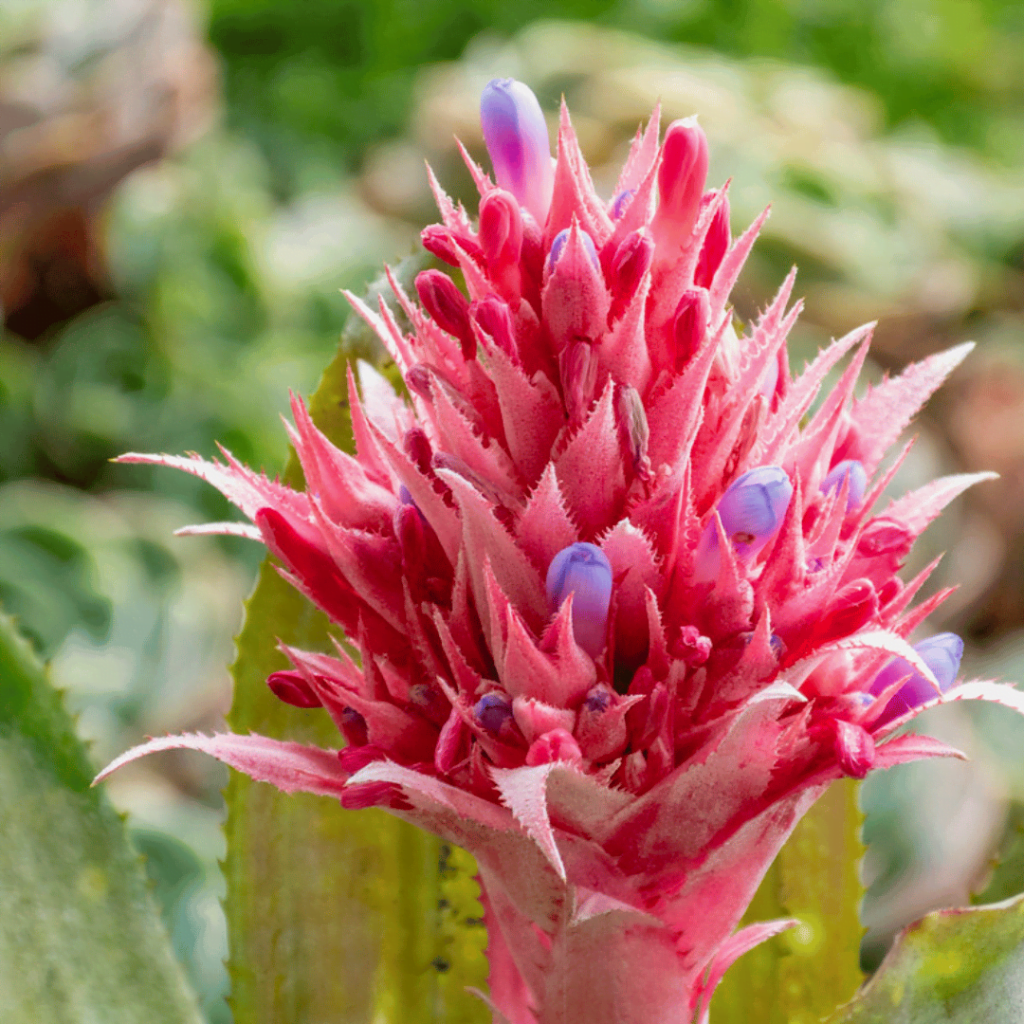Introduction
The indoor plant world offers an astounding variety of specimens, each with its unique charm and specific care regimen. Among these indoor marvels, the Aechmea fasciata, popularly known as the Urn Plant, stands out as an eye-catching yet forgiving addition to your green space. In this comprehensive review, we delve deep into the care, peculiarities, and requirements of this beautiful bromeliad. Read on for a detailed guide on nurturing your Aechmea fasciata to its full potential.
Urn Plant (Aechmea fasciata) Indoor Plant Details
| Specification | Detail |
|---|---|
| Common Names | Urn Plant, Silver Vase Plant |
| Botanical Name | Aechmea fasciata |
| Family | Bromeliaceae |
| Plant Type | Evergreen perennial |
| Mature Size | Up to 1-2 feet tall, with a similar width |
| Sun Exposure | Prefers bright, indirect light. Avoid direct sunlight |
| Soil Type | Well-draining potting mix, often a blend of bark, peat, and perlite |
| Soil pH | Slightly acidic to neutral (6.0 to 7.5) |
| Bloom Time | Typically in summer, but can vary |
| Flower Color | Bright pink bracts with small purple flowers |
| Hardiness Zones | 10-11 (primarily grown indoors in cooler zones) |
| Native Area | Brazil, particularly the Brazilian rainforests |
| Benefit | Acts as an air purifier, removing toxins and improving indoor air quality. Also serves as an attractive ornamental piece due to its unique shape and vibrant color |
Remember, while the Aechmea fasciata can be grown outdoors in certain zones, it’s primarily treasured as an indoor plant, making it vital to provide a habitat that closely resembles its native environment for the best growth results.
Plant Care
Ensuring optimal care for the Urn Plant primarily involves understanding its native habitat. Originating from the Brazilian rainforests, Aechmea fasciata has evolved to thrive under the forest canopy, drawing nourishment from decaying leaves and other organic matter. This background sets the stage for the care regimen it demands in an indoor setting.
Light
Being a typical understory plant, the Aechmea fasciata doesn’t crave intense direct sunlight. Instead, it thrives best under bright, indirect light. A north or east-facing window would be ideal for this plant. If placed in a south or west-facing window, ensure it’s protected by a sheer curtain to diffuse the light. A prolonged exposure to harsh sunlight can cause the leaves to burn or bleach, depriving your plant of its vibrant color.
Soil
Contrary to popular belief, the Urn Plant does not root deep into the soil for sustenance. Instead, its roots serve primarily for anchorage. A well-draining mix, like orchid potting mix, ensures that the plant doesn’t sit in soggy conditions, which can lead to root rot. It’s essential to provide ample aeration to the roots, making a mixture of bark, perlite, and peat an excellent choice.
Water
Watering the Urn Plant requires a dual approach. Firstly, the central “urn” or “vase” (the rosette of tightly packed leaves) should always have some water in it. Rainwater is the best option, but if unavailable, tap water left out for a day to allow chlorine to dissipate works fine. Secondly, for the soil, let it dry out between waterings. It’s vital to avoid overwatering to prevent root rot.
Temperature and Humidity
Hailing from tropical rainforests, the Aechmea fasciata enjoys high humidity and warm temperatures. A range of 60-75°F (15-24°C) is optimal. During hot summer days, a light misting can replicate the humidity of its natural habitat. However, keep your Urn Plant away from cold drafts, air conditioning vents, and heaters.
Fertilizer
While the Aechmea fasciata isn’t particularly demanding in terms of feeding, a balanced, water-soluble fertilizer diluted to half strength during its growing season (spring and summer) can bolster its growth. Monthly applications should suffice, ensuring you avoid over-fertilizing, which can lead to burnt leaf tips.
Pruning
Pruning your Urn Plant isn’t just about aesthetics; it’s also about encouraging health and vitality. Remove dead or yellowing leaves at the base to ensure the plant directs its energy to new growth. Once the plant has flowered, the mother plant will slowly die, but before that happens, it’ll produce offsets or pups. These can be pruned and propagated.
Overwintering
If you live in an area where winter temperatures dip below the plant’s comfort zone, it’s essential to ensure your Urn Plant is kept indoors during these chilly months. Though the plant is not frost-tolerant, it can withstand cooler temperatures for short durations.
Propagating Plant
Propagation is a joy with the Urn Plant. As mentioned, after flowering, the mother plant produces offsets or pups. Once these pups are a reasonable size (at least one-third of the mother plant), they can be gently removed and potted separately in a well-draining mix.
Types of Plant
While the Aechmea fasciata is the most commonly recognized member of the Aechmea genus, there are, in fact, over 250 species within this group. The diversity among them ranges in terms of size, color, and leaf pattern. Some popular variants include Aechmea ‘Blue Rain’, with its striking blue and pink flower spike, and Aechmea recurvata var. benrathii, known for its compact size and vibrant pink inflorescence. Exploring the different types within this genus can open up a world of aesthetic possibilities for plant enthusiasts.
Tips of my Urn Plant turning brown
Watering Issues: Both overwatering and underwatering can lead to brown tips. This plant prefers to be watered sparingly, and the central vase should be filled with water, which needs to be refreshed regularly to avoid stagnation.
Humidity Levels: Low humidity can cause the tips of the leaves to turn brown. Urn Plants prefer higher humidity levels. Increasing humidity around the plant, such as by using a humidity tray or a room humidifier, can help.
Salt and Chemicals in Water: If your tap water is high in salts or fluoride, it might cause the tips of the leaves to turn brown. Try using filtered or distilled water to avoid this issue.
Nutrient Deficiency or Excess: A lack of essential nutrients or an excess of fertilizer can also lead to browning tips. Ensure that you are not over-fertilizing and that the plant is getting a balanced diet of nutrients.
Environmental Stress: Sudden changes in temperature, direct sunlight, or drafts can stress the plant, leading to browning. Make sure your plant is in a stable environment with indirect sunlight and protected from extreme temperatures.
Common Pests & Plant Diseases with Solutions:
The Urn Plant, like any indoor plant, can sometimes face challenges from pests and diseases. Here are the most common issues and their solutions:
- Mealybugs: These pests appear as white, cottony masses on leaves and stems. Solution: Remove with a cotton swab dipped in alcohol or use insecticidal soap.
- Scale: Hard, shield-like bugs that attach to stems and leaves. Solution: Manually remove them or treat the plant with neem oil.
- Fungal Diseases: Overwatering can sometimes lead to fungal issues. Solution: Reduce watering, ensure proper ventilation, and consider using a fungicide if the problem persists.
How to Get the Plant to Bloom
Achieving bloom in an Aechmea fasciata can be one of the most rewarding experiences. Here’s how you can encourage it:
- Provide Optimal Conditions: Ensuring the right light, temperature, and humidity levels is the first step.
- Mature Plant: Only mature plants will bloom, typically those that are at least 3-4 years old.
- Apple Trick: Some plant enthusiasts swear by placing a ripe apple near the plant and covering both with a clear plastic bag for about a week. The ethylene gas released by the apple might encourage blooming.
- Limit Nitrogen: Too much nitrogen can encourage leaf growth at the expense of blooms. Ensure balanced fertilization.
Common Problems with Plant
While the Aechmea fasciata is generally resilient, it can show signs of distress:
- Leaf Droop: Often a result of overwatering. Ensure that the soil dries out between waterings.
- No Blooms: This can be due to inadequate light or the plant being too young.
- Brown Leaves: This can be an indication of low humidity, excessive fertilizer, or both. Adjust conditions accordingly.
By being observant and responsive to the needs of the Aechmea fasciata, you can ensure its continued health and vitality. This bromeliad, with its exotic appearance and manageable care requirements, is bound to become a cherished member of any indoor garden.
Quickly Declining
Though robust, there are signs of distress to watch out for. Yellowing leaves can indicate overwatering, while brown leaf tips might suggest low humidity or over-fertilizing. Ensure you revert to the care guidelines mentioned above if your plant shows these signs.
Reflections and Recommendations
In conclusion, the Aechmea fasciata, with its unique aesthetic and uncomplicated care regimen, is an excellent addition to any indoor plant collection. While it requires certain conditions to truly thrive, its overall resilience makes it a delightful choice even for novice plant enthusiasts.
Frequently Asked Questions
Decode the magic of gardens with our guide to Landscaping Styles Frequently Asked Questions.
- Keep the central urn filled and allow the soil to dry out between waterings.
- This could be due to low humidity, excessive fertilizer, or both. Ensure optimal conditions as discussed above.
- While it prefers bright, indirect light, the Aechmea fasciata can tolerate lower light conditions but may not flower or maintain vibrant color.
- Repotting every 2-3 years is generally sufficient unless the plant outgrows its pot or the soil becomes too compacted.
Recent Posts
- Modern Mural Ideas Transforming Walls into Artworks
- Thematic Table Decor Dressing Your Table for Special Occasions
- Festive Lighting Ideas Brightening Your Home for the Holidays
- Biodegradable Decor Materials Choosing Earth-Friendly Options
- Personalized Space Decor Making Your Home Uniquely Yours
- New Year’s Eve Decor Ringing in the New Year in Style
- Transforming Junk into Decor Upcycling at Its Best
- Second-Life Decor Objects Giving Old Items New Purpose
- Unique Decoration Crafting Standout Ideas for Your Home
- Environmentally Friendly Styling Decor with a Conscience











